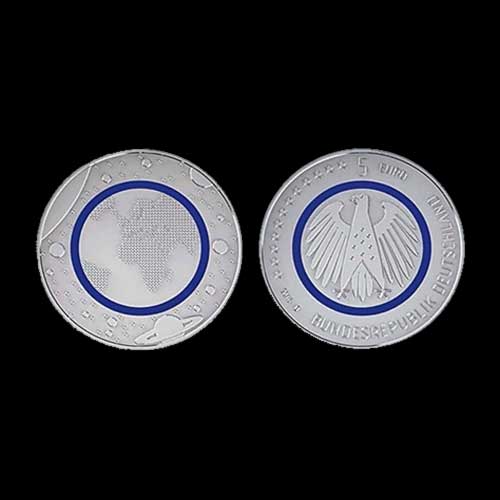German State Mints Introduce Polymer Metal Coins
2018-02-08 Thu
How does it sound if a mint was to hawk polymer as “the other coinage metal? News circulating about innovative polymer coins is a highlight of the new website launched by the German state mints of Baden-Wuerttemberg and Bavaria. The website offers a virtual tour of the Karlsruhe and Stuttgart minting facilities, a view of the production facilities, art medal manufacturing, a catalog of the art medal series Inventors from Baden-Wuerttemberg and news of the progress of polymer as it emerges as an option to metal as a composition for coins.The website doesn’t indicate how durable a polymer coin would be when compared to either a metal coin or a paper banknote. However, the website states that central banks are going to save a lot of money, since polymer coins are comparatively cheaper than printing banknotes, but with the same level of security. The coin becomes more secured because of the polymer ring inserted between the ring and the core.
The colored polymer ring is not only attractive but also constitutes an overt security feature that is easily discernible for every user. At the same time, it offers the possibility to equip the coin with covert security features which no counterfeiter is able to copy at the present state of the art. The new polymer coin would thus make an ideal material for raising the coin-note-boundary.
The German mints developed polymer for use in a coin with assistance from the Leibniz Institute at the Rheinisch-Westfälische Technische Hochschule or RWTH in Aachen, the vending industry through Crane Payment Innovations in Buxtehude, coinage blank supplier Saxonia EuroCoin, and the German Bundesbank or central bank.
There is a good feature attached with Polymer coins as they have conductivity, chemical resistance, and durability when exposed to significant temperature variations or to UV radiation or to water. The material has been certified as being resistant by the RWTH.
The mints of Baden-Wuerttemberg are state-owned. The facilities issue about 40 percent of Germany’s euro coinage. Also, other mint products include foreign circulation strike and commemorative coins as well as medals. Clients include foreign central banks and individuals. German coin products can only be purchased through Official Sales Agency for Collector’s Coins of the Federal Republic of Germany.
Baden-Wuerttemberg released 2 million polymer composition Climate Zones of the Earth 5-euro coins into circulation in 2016. The coins were hoarded by the public and now sell for above face value in collector markets.
The coin was awarded a prize as the Most Innovative Circulating Coin Worldwide at the Mint Directors Conference in May 2017.
Germany is not the first currency issuing authority to issue polymer coins. The rebellious eastern Moldova-Ukraine border region of Transnistria issued polymer coins in denominations of 1, 3, 5 and 10 rubles in 2014. Each of these coins matches a bank note of the same denomination in appearance and color.
Latest News
-
Gold Pagoda of Vijaynagar Empire King Deva Raya I
2024-04-10 WedKing Deva Raya I of the Vijayanagara Empire was a patron of Kannada literature and architecture. He ...
-
Silver Denarius of Septimus Severus
2024-04-05 FriLucius Septimius Severus served as the Roman emperor from 193 to 211 AD. Severus sat on the throne o...
-
Extremely rare 'Malaharamari' type Gold Gadyana of King Guhalladeva-III Sold for INR 611000
2024-04-03 WedTribhuvanamalla, also known as Guhalladeva III, was the ruler of the Kadamba dynasty. His reign coin...
-
90 Years of RBI
2024-04-02 TueOn 1st April, PM #Modi unveiled a special commemorative coin marking 90 Years since the foundation o...
-
Silver Denarius of Julia Mamaea
2024-04-02 TueJulia Avita Mamaea, a Christian Syrian noblewoman, was the mother of Roman Emperor Alexander Severus...

